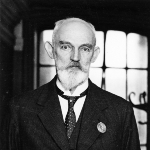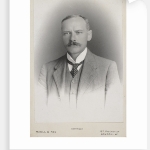Background
Dirk Brouwer was born on September 1, 1902, in Rotterdam, Netherlands. He was the fourth of six children born to Martinus Brouwer, a government employee, and his wife Louisa van Wamelen.

Astronomer educator scientist author
Dirk Brouwer was born on September 1, 1902, in Rotterdam, Netherlands. He was the fourth of six children born to Martinus Brouwer, a government employee, and his wife Louisa van Wamelen.
Brouwer studied under Willem de Sitter at Leiden University, where he received the Doctor of Philosophy degree in 1927. He also received the Doctor of Science (honorary) degree from the University of La Plata in 1959.
After studying at the University of Leiden, Brouwer then came to the United States on a year’s fellowship and joined the faculty of Yale University in 1928 as an instructor. In 1941 he became both a professor of astronomy and successor to Frank Schlesinger as director of the Yale Observatory, posts he held, together with the editorship of the Astronomical Journal, for the rest of his life.
At Yale, Brouwer first assisted Ernest William Brown in his search for differences between predicted and observed positions of the moon that would reveal changes in the earth’s rotation. In 1930 he found that some of the differences were due to incorrectly located reference stars. To get better positions for these stars, Brouwer turned to asteroids ( 1935), later investigating the origins of these small bodies in a paper extending the membership in Hirayama’s families (1951) and one on Kirkwood’s gaps (1963).
After Brown’s death in 1938, Brouwer took up more general orbital problems. Papers he published in 1938 and 1946 formed the basis for a direct determination of planetary positions by stepwise numerical integration, which was realized in Coordinates of the Five Outer Planets, 1653-2060 (1951), written jointly with Wallace John Eckert and Gerald Maurice Clemence. This was the first astronomical problem to be solved through the use of a high-speed computer. In an address delivered in 1955, when he was awarded the Gold Medal of the Royal Astronomical Society for his outstanding contributions to celestial mechanics, Brouwer outlined the way in which computer techniques were changing his field.
The advent of artificial earth satellites in 1957 provided an application for two theoretical papers Brouwer had written in 1946 and 1947, and led to two more (1959, 1961) of significant merit.
Brouwer made consisted of developing general methods for finding orbits and computing errors and then applying these methods to comets, asteroids, and planets. All of this clearly required an enormous amount of computation, an activity which must have been nightmarish at best during the pre-computer period, when most of his initial work was done. Brouwer, as a result, was one of the first to introduce computers to the making of these astronomy computations.
During the early periods of the artificial satellites, Brouwer computed their orbits and from the data collected, was able to develop a better understanding and knowledge of the figure of planet earth.
He was elected to the National Academy of Sciences in 1951, given an honorary Doctor of Science by the University of La Plata in 1961. In 1966, Brouwer was awarded the prestigious Bruce Medal posthumously. The Bruce Medal is one of the more prestigious medals in Astronomy. The Bruce Medal is awarded by the Astronomical Society of the Pacific [ASP], which was founded in San Francisco in 1889, in order to advance the science and knowledge of astronomy.
In 1978, the American Astronomical Society honored Brouwer posthumously by establishing the Dirk Brouwer Award. The Dirk Brouwer Award is awarded annually by the Division on Dynamical Astronomy of the American Astronomical Society for outstanding lifetime achievement in the field of dynamical astronomy. Many prestigious astronomers in the field of dynamical astronomy have received the award annually since 1978.
Brouwer is remembered for two other astronomical discoveries during his lifetime career in astronomy. They are the “Brouwer Crater on the moon”, and the asteroid named “Asteroid 1746 Brouwer”.
Brouwer was an active member of the International Astronomical Union and influential in its adoption of a new set of fundamental astronomical constants in 1964. He was also a member American Association for the Advancement of Science, American Astronomical Society, American Association Variable Star Observers (president 1941-1943), Astronomical Society of Pacific, International Astronomical Union, National Academy Sciences, American Academy Arts and Sciences, Royal Astronomical Society (foreign associate), Royal Netherlands Academy Sciences (correspondent), American Geophysical Union, Buenos Aires Academy Sciences (correspondent 1961), Sigma Xi.
Dirk Brouwer was married on November 1, 1928 to Johanna de Graaf and became an American citizen in 1937.

